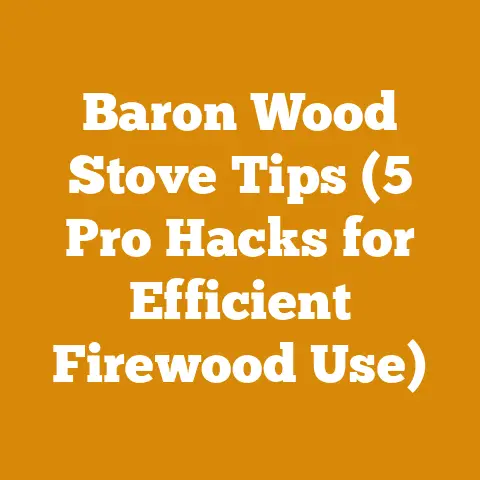How to Burn Creosote Out of Chimney (3 Pro Tips for Safe Removal)
Expert Tip: Before diving into the nitty-gritty of creosote removal, remember this: prevention is always better than cure. Regularly inspecting and cleaning your chimney is the best way to keep creosote buildup at bay. Think of it like changing the oil in your car – a little maintenance goes a long way.
How to Burn Creosote Out of Chimney (3 Pro Tips for Safe Removal)
Creosote. The word itself can send shivers down the spine of any wood-burning enthusiast. This dark, oily, and potentially flammable substance is a byproduct of burning wood, and it loves to cling to the inside of your chimney. If left unchecked, creosote buildup can lead to chimney fires, a homeowner’s worst nightmare. But don’t despair! Removing creosote is manageable with the right knowledge and precautions. In this article, I’ll walk you through three proven methods for safely removing creosote, sharing insights and best practices gleaned from years of experience in the wood-burning world. We’ll also delve into the costs associated with each method, so you can make an informed decision based on your budget and skill level.
Understanding Creosote: A Primer for the Wood Burner
Before we dive into removal techniques, let’s understand what we’re dealing with. Creosote isn’t just one thing; it comes in three stages, each with its own characteristics and dangers:
- Stage 1 (Soot): This is the easiest to remove. It’s a light, flaky deposit that resembles soot. Good news: regular chimney sweeping can usually handle this stage.
- Stage 2 (Flake): This is where things start to get trickier. Stage 2 creosote is a hard, crusty deposit that’s more difficult to remove than soot.
- Stage 3 (Glaze): The most dangerous and difficult to remove. This is a shiny, tar-like substance that’s highly flammable. It can be extremely difficult to remove without professional help.
The type of wood you burn, the efficiency of your stove or fireplace, and your burning habits all contribute to creosote buildup. Burning unseasoned wood, for example, creates more smoke and thus more creosote. A slow, smoldering fire is also a creosote factory.
Why is creosote so dangerous? Creosote is highly flammable. When it ignites, it creates a chimney fire, which can quickly spread to your home. Chimney fires can reach extremely high temperatures, damaging your chimney and potentially causing structural damage to your house.
Pro Tip #1: The DIY Approach – Chemical Creosote Removers
For light to moderate creosote buildup (primarily Stage 1 and perhaps some Stage 2), chemical creosote removers can be a viable DIY option. These products come in various forms, including powders, sprays, and chimney sweeping logs.
How They Work: Chemical creosote removers contain compounds that react with the creosote, drying it out and making it more brittle. This makes it easier to remove through subsequent chimney sweeping. Chimney sweeping logs contain chemicals that are released as they burn, coating the inside of the chimney and helping to loosen creosote deposits.
My Experience: I’ve used chimney sweeping logs with some success on my own wood stove. I found they worked best when used regularly as a preventative measure. However, I wouldn’t rely on them alone to remove heavy creosote buildup.
Cost Breakdown:
- Chimney Sweeping Logs: These typically cost between $10 and $20 per log. You’ll likely need to use several logs over the course of a heating season.
- Creosote Remover Powders/Sprays: These range from $15 to $30 per container.
Total DIY Chemical Removal Cost (Estimate): $50 – $100 per year. This estimate assumes regular preventative use of chimney sweeping logs and occasional use of creosote remover powders or sprays.
Important Considerations:
- Effectiveness: Chemical removers are most effective on Stage 1 and light Stage 2 creosote. They may not be sufficient for heavy buildup or Stage 3 creosote.
- Safety: Always follow the manufacturer’s instructions carefully. Wear appropriate safety gear, such as gloves and eye protection. Ensure proper ventilation when using these products.
- Sweeping Required: Chemical removers loosen the creosote, but you’ll still need to sweep the chimney afterward to remove the loosened deposits.
- Wood Type: Burning softwoods like pine contribute to creosote buildup more than hardwoods like oak or maple. If you burn softwoods frequently, you might need more frequent chemical treatments.
A Word of Caution: While chemical removers can be helpful, they are not a substitute for professional chimney sweeping. If you have any concerns about the condition of your chimney or the amount of creosote buildup, it’s always best to consult with a qualified chimney sweep.
Pro Tip #2: The Mechanical Method – DIY Chimney Sweeping
For those comfortable with a bit of elbow grease, DIY chimney sweeping is a cost-effective way to remove creosote. This involves using a chimney brush and rods to physically scrub the inside of the chimney.
Tools You’ll Need:
- Chimney Brush: Choose a brush that’s the correct size and shape for your chimney flue. Options include wire brushes for metal flues and poly brushes for masonry flues. Cost: $30 – $60
- Chimney Rods: These connect to the brush and allow you to reach the entire length of the chimney. Cost: $10 – $20 per rod (you’ll need enough to reach the top of your chimney)
- Safety Glasses: Protect your eyes from falling debris. Cost: $5 – $10
- Dust Mask or Respirator: Protect your lungs from inhaling soot and creosote particles. Cost: $10 – $30
- Drop Cloths: Cover your fireplace opening and surrounding area to protect your floors and furniture. Cost: $10 – $20
- Gloves: Protect your hands from dirt and abrasion. Cost: $5 – $10
My Experience: I’ve swept my chimney myself for years, and it’s a satisfying feeling to know you’re keeping your home safe. However, it can be a dirty and physically demanding job. It’s also important to be comfortable working at heights if you need to access the chimney from the roof.
Cost Breakdown:
- Chimney Brush: $30 – $60
- Chimney Rods (e.g. 10 rods @ $15 each): $150
- Safety Gear (Glasses, Mask, Gloves): $20 – $50
- Drop Cloths: $10 – $20
Total DIY Sweeping Cost (Initial Investment): $210 – $280. This is a one-time investment, as you can reuse the tools for multiple chimney sweeps.
Sweeping Frequency: The National Fire Protection Association (NFPA) recommends that chimneys be inspected at least once a year and cleaned as needed. If you burn wood frequently, you may need to sweep your chimney more often.
DIY Chimney Sweeping Steps:
- Preparation: Cover the fireplace opening with drop cloths and secure them with tape. Wear safety glasses, a dust mask, and gloves.
- Assembly: Connect the chimney brush to the first rod.
- Sweeping: Insert the brush into the chimney flue and push it upwards, adding rods as needed to reach the top of the chimney. Use a twisting motion to scrub the walls of the flue.
- Removal: Slowly pull the brush and rods back down, removing the rods one by one.
- Cleanup: Carefully remove the drop cloths and dispose of the soot and creosote in a sealed bag. Vacuum the fireplace and surrounding area.
- Inspection: After sweeping, inspect the chimney flue for any signs of damage or excessive creosote buildup.
Important Considerations:
- Chimney Type: The type of chimney you have will affect the type of brush you need. Metal chimneys require wire brushes, while masonry chimneys require poly brushes.
- Chimney Height: Make sure you have enough rods to reach the top of your chimney.
- Safety: Working on a roof can be dangerous. If you’re not comfortable working at heights, it’s best to hire a professional.
- Creosote Stage: DIY sweeping is most effective for Stage 1 and Stage 2 creosote. Stage 3 creosote may require professional removal.
Cost-Saving Tips:
- Buy a Chimney Sweeping Kit: These kits typically include a brush, rods, and other essential tools at a discounted price.
- Share Tools with Neighbors: If you have neighbors who also burn wood, consider sharing the cost of chimney sweeping tools.
- Sweep Regularly: Regular sweeping prevents creosote from building up to dangerous levels, making the job easier and reducing the risk of chimney fires.
Pro Tip #3: The Professional Touch – Hiring a Chimney Sweep
When dealing with heavy creosote buildup, Stage 3 creosote, or if you’re simply not comfortable doing it yourself, hiring a professional chimney sweep is the safest and most effective option.
What to Expect from a Professional Chimney Sweep:
- Inspection: A thorough inspection of your chimney to assess the level of creosote buildup and identify any potential problems.
- Sweeping: Professional chimney sweeps use specialized tools and techniques to remove creosote effectively and safely.
- Repairs: If they find any damage to your chimney, they can recommend and perform necessary repairs.
- Peace of Mind: Hiring a professional gives you the peace of mind knowing that your chimney is clean and safe to use.
My Experience: I’ve hired professional chimney sweeps on several occasions, especially when I suspected Stage 3 creosote buildup or when I needed a thorough inspection of my chimney system. They have the expertise and equipment to handle even the most challenging situations.
Cost Breakdown:
- Chimney Sweeping Fee: The cost of a professional chimney sweep typically ranges from $150 to $300, depending on the complexity of the job and your location.
- Inspection Fee (If Separate): Some chimney sweeps charge a separate fee for inspections, typically around $50 to $100.
- Repairs (If Needed): The cost of repairs can vary widely depending on the type and extent of the damage.
Total Professional Sweeping Cost (Estimate): $150 – $300 per sweep. This is a general estimate, and the actual cost may vary depending on your specific situation.
Factors Affecting the Cost of Professional Chimney Sweeping:
- Location: Prices vary depending on your geographic location. Urban areas tend to have higher prices than rural areas.
- Chimney Height: Taller chimneys may cost more to sweep.
- Creosote Level: Heavy creosote buildup may require more time and effort to remove, increasing the cost.
- Chimney Type: Some chimney types are more difficult to sweep than others, which can affect the price.
- Additional Services: If you need additional services, such as a chimney inspection or repair, the cost will be higher.
How to Find a Qualified Chimney Sweep:
- Certification: Look for chimney sweeps who are certified by the Chimney Safety Institute of America (CSIA) or a similar organization.
- Insurance: Make sure the chimney sweep is properly insured.
- References: Ask for references from previous customers.
- Estimates: Get estimates from several chimney sweeps before making a decision.
- Reviews: Check online reviews to see what other customers have to say about their experience.
Questions to Ask a Chimney Sweep:
- Are you certified?
- Are you insured?
- How long have you been in business?
- What is your process for sweeping a chimney?
- What type of equipment do you use?
- What are your fees?
- Do you offer any guarantees?
Cost-Saving Tips:
- Schedule an Off-Season Sweep: Chimney sweeps are often less busy during the spring and summer months, so you may be able to get a better price.
- Combine Services: If you need multiple services, such as a chimney sweep and an inspection, you may be able to get a discount.
- Negotiate: Don’t be afraid to negotiate the price.
The Wood Factor: Impact of Wood Type and Seasoning on Creosote
As I mentioned earlier, the type of wood you burn plays a significant role in creosote buildup. Softwoods, like pine and fir, contain more sap and resins than hardwoods, like oak and maple. This means they produce more smoke when burned, leading to increased creosote accumulation.
Seasoning is Key: Burning unseasoned (wet) wood is a creosote disaster waiting to happen. Wet wood doesn’t burn efficiently, producing excessive smoke and moisture. This moisture mixes with the smoke, creating a sticky residue that clings to the chimney walls and hardens into creosote.
My Experience: I learned this lesson the hard way when I first started burning wood. I tried to burn some freshly cut pine, and it was a smoky, sputtering mess. Not only did it produce very little heat, but it also coated my chimney with a thick layer of creosote.
Best Practices for Wood Selection and Seasoning:
- Choose Hardwoods: Whenever possible, burn hardwoods like oak, maple, ash, and birch.
- Season Your Wood: Season your wood for at least six months, preferably a year. This allows the wood to dry out, reducing its moisture content.
- Store Wood Properly: Store your wood in a dry, well-ventilated area, off the ground.
- Monitor Moisture Content: Use a moisture meter to check the moisture content of your wood. Ideally, it should be below 20%.
The Cost of Good Wood:
- Hardwood Firewood: Prices vary depending on your location and the type of wood. Expect to pay between $200 and $400 per cord for seasoned hardwood.
- Softwood Firewood: Softwood is typically cheaper than hardwood, but it’s not recommended for regular use due to its high creosote production.
- Moisture Meter: A good moisture meter costs between $20 and $50.
Investing in good wood and proper seasoning practices is an investment in the safety and longevity of your chimney. It can also save you money in the long run by reducing the need for frequent chimney sweeps.
Fuelwood Market Rates (Global Perspective):
Fuelwood market rates fluctuate significantly depending on the region and the type of wood. In North America, seasoned hardwood typically commands the highest prices. In Europe, prices can vary widely depending on the country and the availability of wood resources. In developing countries, fuelwood is often a primary source of energy, and prices can be affected by factors such as deforestation and government regulations.
Data Points:
- United States: The average price per cord of seasoned hardwood firewood ranges from $250 to $350, according to the USDA Forest Service.
- Europe: In some European countries, the price of firewood can be as high as €400 per cubic meter, according to the European Commission.
- Developing Countries: In many developing countries, fuelwood is gathered rather than purchased, but the cost of transportation and labor can be significant.
Budgeting for Firewood Preparation: A Case Study
Let’s consider a case study of a homeowner who wants to prepare their own firewood for the winter. They have access to a supply of free logs, but they need to invest in tools and equipment.
Assumptions:
- Homeowner has access to free logs.
- Homeowner needs 5 cords of firewood for the winter.
- Homeowner already owns a chainsaw.
Cost Breakdown:
- Log Splitter Rental: $50 – $100 per day (assuming 2 days of rental) = $100 – $200
- Chainsaw Fuel and Oil: $50
- Safety Gear (Helmet, Chaps, Gloves): $100 – $200 (if not already owned)
- Transportation (Truck Rental or Gas): $50 – $100
- Miscellaneous (Wedges, Sledgehammer): $20 – $50
Total Firewood Preparation Cost (Estimate): $320 – $600 for 5 cords. This works out to $64 – $120 per cord.
Comparison to Buying Firewood:
If the homeowner were to buy 5 cords of seasoned hardwood firewood at $300 per cord, the total cost would be $1500.
Conclusion:
In this case study, preparing your own firewood can be significantly cheaper than buying it, even after factoring in the cost of tools and equipment. However, it’s important to consider the time and effort involved. Preparing 5 cords of firewood is a significant undertaking, and it may not be feasible for everyone.
Cost Optimization Tips for Wood Processing and Firewood Preparation
- Buy Wood in Bulk: Buying wood in bulk is typically cheaper than buying it in smaller quantities.
- Season Your Wood Yourself: Seasoning your own wood can save you money compared to buying seasoned firewood.
- Share Tools with Neighbors: Share the cost of expensive tools, such as log splitters, with your neighbors.
- Look for Free Wood: Check with local tree services or logging companies for free wood.
- Use a Wood Stove Efficiently: Burning wood efficiently can reduce the amount of firewood you need.
- Maintain Your Equipment: Regularly maintain your chainsaw and other wood processing tools to prolong their lifespan and prevent costly repairs.
Technical Explanations and Formulas
- Calculating Volume of Logs in Cords: A cord of wood is a stack that measures 4 feet high, 4 feet wide, and 8 feet long, totaling 128 cubic feet. However, the actual amount of solid wood in a cord is less than 128 cubic feet due to air spaces between the logs.
- Estimating Drying Time Based on Moisture Content: The drying time for firewood depends on several factors, including the type of wood, the climate, and the storage conditions. A general rule of thumb is that firewood needs to be seasoned for at least six months to reach a moisture content below 20%.
- Calculating BTU Content of Different Wood Species: The BTU (British Thermal Unit) content of wood varies depending on the species. Hardwoods typically have a higher BTU content than softwoods, meaning they produce more heat when burned.
Actionable Takeaways and Next Steps
- Inspect Your Chimney Regularly: Inspect your chimney at least once a year for creosote buildup and other potential problems.
- Choose the Right Creosote Removal Method: Choose the creosote removal method that’s best suited for your situation, based on the level of creosote buildup and your comfort level.
- Burn Seasoned Hardwood: Burn seasoned hardwood to reduce creosote buildup and improve the efficiency of your wood stove or fireplace.
- Hire a Professional Chimney Sweep When Necessary: Don’t hesitate to hire a professional chimney sweep if you’re not comfortable doing it yourself or if you suspect heavy creosote buildup.
- Budget for Firewood Preparation: Create a budget for firewood preparation to ensure you have the necessary tools and equipment.
- Prioritize Safety: Always prioritize safety when working with wood processing tools and equipment.
Final Thoughts: A Safe and Warm Winter Awaits
Removing creosote from your chimney is an essential part of maintaining a safe and efficient wood-burning system. By understanding the different creosote removal methods, choosing the right wood, and following proper safety precautions, you can enjoy a warm and worry-free winter. Remember, a little prevention goes a long way, so regular chimney inspections and maintenance are key. And if you’re ever in doubt, don’t hesitate to call in the professionals. After all, your safety and peace of mind are priceless.






